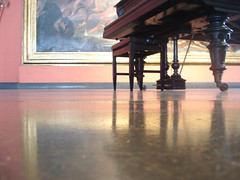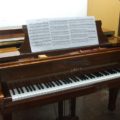Many grand aged pianos still have a significant amount of life left in them, but only if they receive a little love and care. Piano restoration is the ultimate demonstration of that affection, as even a 100-year-old grand piano with numerous scratches and dead strings can be revived to produce the awe-inspiring notes and tones it once did when it was newly crafted.
But how exactly does the process of restoring the piano’s former beauty unfold?
- Evaluation Similar to how a doctor diagnoses a patient before proceeding with treatment, experts assess the condition of the piano before focusing their efforts on specific components that require the most attention.
The initial step in piano restoration involves taking measurements of the instrument, from the string height to the original finish samples, which will serve as a reference for the final procedure. These measurements will not only assist in addressing the piano’s issues but also guide the restoration team in making informed decisions to restore the piano to its original grandeur.
- The Soundboard
The soundboard, often referred to as the “soul” of the piano, is where the sound resonates and reverberates, creating that distinctive sound that only a high-quality piano can produce.
Piano restoration teams understand the intricate structure of the soundboard, including everything from the strings and iron frame to the piano ribs. Every component inside the soundboard has a significant impact on the overall sound produced, and only skilled professionals comprehend the intricacies of its construction.
- The Keys The piano keys establish the connection between a pianist and the instrument, enabling the creation of music in the first place.
For a piano’s keys to provide the perfect “feel” for a pianist’s sensitive fingers, the wood, metal, and felt must be in top-notch condition. Restoration specialists meticulously inspect the keys for signs of wear or deterioration and address any issues to ensure optimal performance.
- The Action If the keys connect the pianist to the piano and the soundboard refines the produced sound into musical notes, then the action is the component responsible for initiating the sound.
The action, comprising hammers, hammer shanks, and flanges, is a crucial part of the piano’s internal mechanics. Dealing with corrosion and deterioration is essential, but so is addressing the matter of adjustment. Misuse and neglect can lead to loose pins, and an expert is trained to handle these issues accurately.
- The Finish Naturally, a grand old piano cannot truly be considered a work of art without restoring its finish.
Piano restoration not only addresses the instrument’s functional issues but also involves revitalizing the finish to bring back its original beauty. From grain filling to lacquering to staining the wood to achieve a desired tone, this final step in the restoration process not only rejuvenates the piano but also fills the owner with a sense of radiant pride.
Manuel Marino is a seasoned Senior Producer, Music Composer, and Artist with over a decade of experience. He specializes in branded entertainment across various mediums, including video games, films, and advertising campaigns. With 20+ years as a game music composer, Manuel has worked on numerous platforms, creating diverse orchestral soundtracks. HIRE ME


 Manuel is a passionate, driven, and techsavvy AV technician,
Manuel is a passionate, driven, and techsavvy AV technician, 





